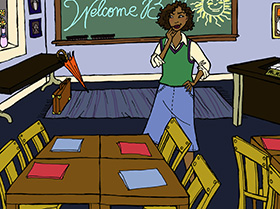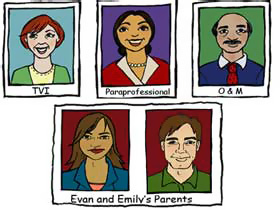What resources should Ms. Milton consult to learn more about Evan’s and Emily’s needs?
Page 1: Getting Started

It is certainly understandable that Ms. Milton feels at a loss about how to prepare for the inclusion of Evan and Emily in her classroom with only 3 days left before school starts. She needs to reorganize her room, set up and become familiar with new equipment, and think about how she’s going to facilitate Evan’s and Emily’s participation in student work groups.
Some adjustments will likely be necessary for safety, and other modifications will increase the ease and efficiency with which students with visual impairments can function in the classroom. But in actuality, major changes in the classroom are rarely needed for the inclusion of students with visual disabilities. Additionally, it is usually the case that all students in the class benefit from classroom arrangements that are helpful for students with visual impairments. For example, organizing materials and keeping them in consistent places not only helps students with visual disabilities, but it also helps all the students in the class.
Establishing Your Resources
 Before Ms. Milton tackles all these issues related to the arrival of Evan and Emily, her first priority should be to consult their individualized education programs (IEPs) . The IEP will serve to guide her as she develops a plan of action to meet their needs. In addition, the IEP will identify members of the students’ support teams. Ms. Milton should contact each member of the support teams to gather information on the students’ strengths and weaknesses, disability-related information, and the best methods of inclusion for the students. The members of the support teams may include:
Before Ms. Milton tackles all these issues related to the arrival of Evan and Emily, her first priority should be to consult their individualized education programs (IEPs) . The IEP will serve to guide her as she develops a plan of action to meet their needs. In addition, the IEP will identify members of the students’ support teams. Ms. Milton should contact each member of the support teams to gather information on the students’ strengths and weaknesses, disability-related information, and the best methods of inclusion for the students. The members of the support teams may include:
individualized education programs (IEPs)
A document created to ensure that students with special needs receive the services they require to succeed in school. It is developed by a team that often includes parents, teachers, and other education professionals. The IEP generally includes a student’s strengths and weaknesses, academic goals, instructional and physical accommodations and/or modifications, and a list of additional services and/or assistive technology devices.
- Family members or parental guardians of the student with the visual disability
- The teacher of students with visual impairments (TVI)
- The orientation and mobility (O&M) specialist
- Paraprofessionals and other professionals
teacher of students with visual impairments (TVI)
A specially trained and certified teacher who provides direct and/or consultative educational services for students with vision impairments. Services provided include assessment of unique learning needs and visual functioning in the learning environment; direct instruction in adaptive skills (e.g., reading braille) and other aspects of the expanded core curriculum, including reading and writing in alternate media; and adaptation of the learning environment. The TVI also works with school staff and students’ families (adapted from Spungin (2002)).
orientation and mobility (O&M) specialist
Professionals who work with students with visual impairments to teach the orientation and mobility skills needed to travel efficiently and safely in the school and community environments. The O&M specialist provides one-on-one instruction on the use of travel devices as well as fine and gross motor skills.
Paraprofessionals and other professionals
Paraprofessionals – Paraprofessionals provide instructional support to students with visual disabilities. This may include working (under the supervision of the TVI) directly with a student who is visually impaired or providing assistance with various classroom activities.
Other professionals – Other professionals include those who provide various types of support services for students with visual impairments (e.g., braille transcriber, technology specialist).
Keep in Mind
It’s a good idea to gather contact information for each member of the support team and keep it in one place for easy reference. Click here for a contact form that you can use.
Contacts for Information and Assistance
STUDENT_________________________________________________ DATE_____________________________________
| RESOURCE | HOME PHONE | WORK PHONE | CELL PHONE | |
| TVI | ||||
| O&M Specialist | ||||
| Family | ||||
| Paraprofessional | ||||
| Other: | ||||
| Other: |